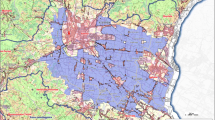Abstract
Spores of many fungal pathogens are dispersed by wind. Detection of these airborne inocula is important in forecasting both the onset and the risk of epiphytotics. Species-specific primers targeted at the internal transcribed spacer (ITS) region ofLeptosphaeria maculans andL. biglobosa — the causal organisms of phoma stem canker and stem lesions ofBrassica spp., including oilseed rape — were used to detect DNA extracted from particles deposited on tapes obtained from a spore trap operated in Rarwino (northwest Poland) from September to November in 2004 and 2006. The quantities of DNA assessed by traditional end-point PCR and quantitative real-time PCR were compared to microscopic counts of airborne ascospores. Results of this study showed that fluctuations in timing of ascospore release corresponded to the dynamics of combined concentrations of DNA fromL. maculans andL. biglobosa, with significant positive correlations between ascospore number and DNA yield. Thus the utilization of PCR-based molecular diagnostic techniques enabled the detection, identification, and accurate quantification of airborne inoculum at the species level. Moreover, real-time PCR was more sensitive than traditional PCR, especially in years with low ascospore numbers.
Similar content being viewed by others
References
Fitt BDL, Brun H, Barbetti MJ, Rimmer RS, 2006. World-wide importance of phoma stem canker (Leptosphaeria maculans andL. biglobosa) on oilseed rape (Brassica napus). Eur J Plant Pathol 114: 3–15.
Fountaine JA, Shaw MW, Napier B, Ward E, Fraaije BA, 2007. Application of real-time and multiplex polymerase chain reaction assays to study leaf blotch epidemics in barley. Phytopathology 97: 297–303.
Gladders P, Symonds BV, Hardwick NV, Sansford CE, 1998. Opportunities to control canker (L. maculans) in winter oilseed rape by improving spray timing. Int Org Biol Integr Cont (IOBC) Bull. 21: 111–120.
Graham GC, Mayers P, Henry RJ, 1994. A simplified method for the preparation of fungal genomic DNA for PCR and RAPD analysis. Biotechniques 16: 48–50.
Guo XW, Fernando WGD, 2005. Seasonal and diurnal patterns of spore dispersal byLeptosphaeria maculans from canola stubble in relation to environmental conditions. Plant Dis 89: 97–104.
Hammond KE, Lewis BG, Musa TM, 1985. A systemic pathway for the infection of oilseed rape plants byLeptosphaeria maculans. Plant Pathol 34: 57–65.
Huang YJ, Liu Z, West JS, Todd AD, Hall AM, Fitt BDL, 2007. Effects of temperature and rainfall on date of release of ascospores ofLeptosphaeria maculans (phoma stem canker) from winter oilseed rape (Brassica napus) debris in the UK. Annals Appl Biol 151: 99–111.
Jędryczka M, Kaczmarek J, Dawidziuk A, Brachaczek A, 2008. System for Forecasting Disease Epidemics — aerobiological methods in Polish agriculture. Aspects Appl Biol 89: 65–70.
Kaczmarek J, Fitt BDL, Jędryczka M, Latunde-Dada AO, 2008. Detection by Real-Time PCR and quantification ofLeptosphaeria maculans andL. biglobosa in air samples from north Poland. Aspects Appl Biol 89: 71–76.
Kaczmarek J, Jędryczka M, Irzykowski W, Fitt BDL, Lucas JA, Latunde-Dada AO, 2009. Comparative analyses of ratio between ascospores ofLeptosphaeria maculans andL. biglobosa in air samples, using traditional PCR and Real-time PCR. Dissertations and Monographs, IPG PAS, Poznan, vol. 18 (in press).
Lacey M, West JS, 2006. The air spora: a manual for catching and identifying airborne biological particles. Springer-Verlag GmbH: 156.
Li H, Sivasithamparam K, Barbetti MJ, 2003. Breakdown of aBrassica rapa subsp.sylvestris single dominant blackleg resistance gene inB. napus rape-seed byLeptosphaeria maculans field isolates in Australia. Plant Dis 87: 752.
Luo Y, Ma Z, Reyes HC, Morgan D, Michailides TJ, 2007. Quantification of airborne spores ofMonilinia fructicola in stone fruit orchards of California using real-time PCR. Eur J Plant Pathol 118: 145–154.
Mahuku GS, Hall R, Goodwin PH, 1996. Co-infection and induction of systemic acquired resistance by weakly and highly virulent isolates ofLeptosphaeria maculans in oilseed rape. Physiol Mol Plant Pathol 49: 61–72.
McDevitt JJ, Lees PSJ, Merz WG, Schwab KJ, 2007. Inhibition of quantitative PCR analysis of fungal conidia associated with indoor air particulate matter. Aerobiologia 23: 35–45.
Payne RW, Harding SA, Murray DA, Soutar DM, Baird DB, Welham SJ, et al. 2007. The guide to GenStat release 10, Part 2: Statistics, Oxford: VSN International, UK: 1096.
Paul VH, Rawlinson CJ, 1992. Diseases and pests of oilseed rape. Gelsenkirchen-Buer: Verlag Theodore Mann, Germany.
Rouxel T, Penaud A, Pinochet X, Brun H, Gout L, Delourme R, et al. 2003. A 10-year survey of populations ofLeptosphaeria maculans in France indicates a rapid adaptation towards theRlm1 resistance gene of oilseed rape. Eur J Plant Pathol 109: 871–881.
Shoemaker RA, Brun H, 2001. The teleomorph of the weakly aggressive segregate ofLeptosphaeria maculans. Can J Bot 79: 412–419.
Toscano-Underwood C, Huang YJ, Fitt BDL, Hall AM, 2003. Effects of temperature on maturation of pseudothecia ofLeptosphaeria maculans andL. biglobosa on oilseed rape stem debris. Plant Pathol 52: 726–736.
Walsh K, Korimbocus N, Boonham P, Jennings P, Hims M, 2005. Using real-time PCR to discriminate and quantify the closely related wheat pathogensOculimacula yallundae andOculimacula acuformis. J Phytopathol 153: 715–721.
West JS, Balesdent MH, Rouxel T, Narcy JP, Huang YJ, Roux J, et al. 2002. Colonization of winter oilseed rape tissues by A/Tox(+) and B/Tox(0)Leptosphaeria maculans (phoma stem canker) in France and England. Plant Pathol 51: 311–321.
West JS, Biddulph JE, Fitt BDL, Gladders P, 1999. Epidemiology ofLeptosphaeria maculans in relation to forecasting stem canker severity on winter oilseed rape in the UK. Ann Appl Biol 135: 535–546.
Author information
Authors and Affiliations
Corresponding author
Rights and permissions
About this article
Cite this article
Kaczmarek, J., Jędryczka, M., Fitt, B.D.L. et al. Analyses of air samples for ascospores ofLeptosphaeria maculans andL.biglobosa by light microscopy and molecular techniques. J Appl Genet 50, 411–419 (2009). https://doi.org/10.1007/BF03195702
Received:
Accepted:
Issue Date:
DOI: https://doi.org/10.1007/BF03195702




